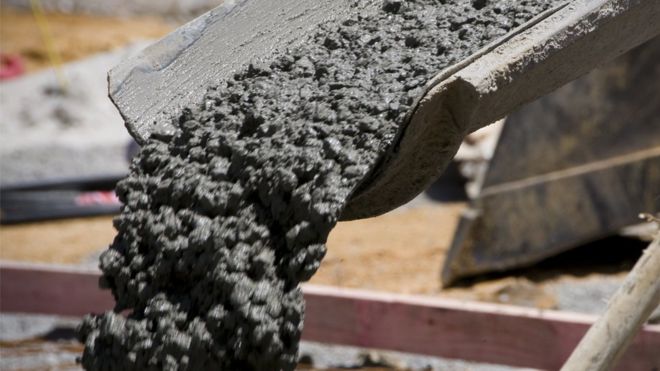TRIVIA DAY: Test Your Concrete Knowledge!
According to the social media gods, today is National Trivia Day! In honor of this made-up holiday, we challenge you to test your concrete knowledge with How Stuff Works' "Ultimate Concrete Quiz":
1. Which culture is the earliest on record to have used a concrete-type mixture?
Egypt
Greece
Rome
China
2. Concrete is a mixture of two components: aggregates and what?
Straw
Paste
Sand
Gravel
3. What was the aggregate that was used in more primitive times?
Bones
Sand
Crushed stone
Straw
4. How are aggregates categorized?
Size
Shape
Color
Material
5. What is used as the paste in modern concrete-making?
Mud
Cement
Dough
Sand
6. Which type of cement is most commonly used in concrete production?
Gypsum cement
Portland cement
Ground quartz
Jurassic cement
7. What activity is concrete-making compared to?
Exercising
Catering
Knitting
Baking
8. What are concrete admixtures?
Stuff accidentally mixed into the concrete
Ingredients that add to the mixture in some way
Purposefully imbalancing the ingredient levels
Equations for concrete mixes
9. What are premixed bags of concrete good for?
Small home projects
Large home renovations
Large industrial building projects
Small roadway fixes
10. Within how long does concrete need to be discharged from the drum after water has been added?
10 minutes
30 minutes
60 minutes
90 minutes
11. What does the term "slump loss" refer to in concrete-making?
Concrete falling out of the drum accidentally
Point at which the concrete is unworkable
A bad mixture of concrete that is unusable
When concrete is too soft and slumps within the steel rods it's reinforcing
12. How is concrete reinforced?
Steel mesh
Steel rods
Both
Neither, concrete is the reinforcer
13. What affects the time concrete takes to dry?
Lunar cycle
Sunlight
Temperature
Air pressure
14. What happens to concrete as it dries?
It shrinks
It cracks
It weakens
It expands
15. What substance is used to speed up concrete curing in cold weather?
Magnesium chloride
Calcium chloride
Calcium carbonate
Magnesium carbonate
ANSWERS
1. EGYPT
As far back as 3000 B.C., the Egyptians used mixtures of lime and gypsum, which is a very similar mixture to concrete. The Romans used a mixture known as opus caementicium.
2. PASTE
The two components of a concrete mixture are aggregates and paste.
3. STRAW
In primitive times, straw was commonly used as an aggregate and mud was the paste. These days commonly used aggregates include sand, various sizes of gravel and crushed stone. However, items such as oyster shells and waste ash from coal-fired plants have also been turned into aggregates.
4. SIZE
Aggregates are categorized by size into fine aggregates and coarse aggregates. Fine aggregates are 0.2 inches (0.5 cm) or smaller and coarse aggregates can be as large as 1.5 inches (3.8 cm).
5. CEMENT
Cement is used as the paste in modern concrete-making. Cement is made from a mixture of materials, including limestone, clay, gypsum, and other chemicals and minerals. The materials are mixed in specific proportions, according to the task they are being used for. They are then burned and ground into a fine powder before being mixed with water.
6. PORTLAND CEMENT
Portland cement is typically used in concrete making. It is a fine powder made from heating up limestone and clay materials in a kiln. This produces 'clinker,' which is then ground up into the powder. Usually some gypsum is added to the mix.
7. BAKING
Making concrete is sometimes compared to baking. Just as the type and quantity of ingredients used to make a cake will affect the way the cake turns out, so the type and amount of ingredients involved in making concrete will strongly influence the strength, permeability and durability of the concrete.
8. INGREDIENTS THAT ADD TO THE MIXTURE IN SOME WAY
Admixtures add in some way to the concrete mixture. This may be by adding color, affecting hydration time or shrinkage rate, or minimizing corrosion of steel beams inside the concrete.
9. SMALL HOME PROJECTS
Premixed bags contain dry concrete that simply needs to be mixed with water. It is ideal for small projects but can get expensive for larger projects.
10. 90 MINUTES
Mixing is often done on-site for large projects. Otherwise the concrete is mixed at the concrete plant and is transferred to the building site in a rotating drum mixer. As a general rule the concrete should be discharged from the mixer within 90 minutes from when the water is added.
11. POINT AT WHICH CONCRETE IS UNWORKABLE
Slump loss is when the concrete becomes unworkable after a certain amount of time has elapsed since water was added to it.
12 BOTH
Reinforced concrete contains steel mesh or rods.
13. TEMPERATURE
Concrete drying is affected by temperature and moisture. High temperature will cause rapid curing, while low temperatures will lengthen the drying process and will produce weaker concrete.
14. IT SHRINKS
Concrete shrinks as it dries and can ruin the slab if shrinking takes place unevenly. To prevent this from happening, the concrete surface should be kept damp while it dries. This uniformly slows the shrinkage.
15. CALCIUM CHLORIDE
Adding calcium chloride to the concrete mixture produces heat and speeds up the curing process in cold weather. In warm weather, construction workers generally work during the cooler part of the day so that the hot temperatures will not affect concrete curing.




